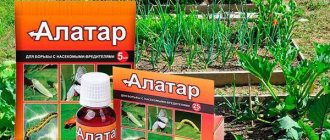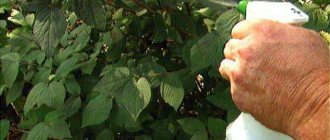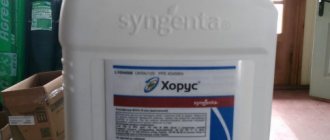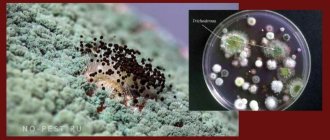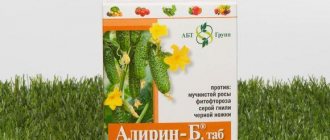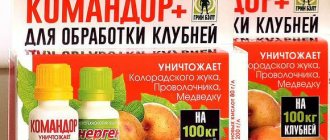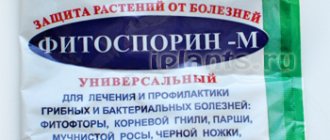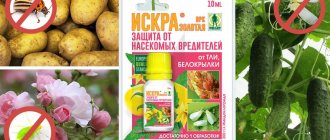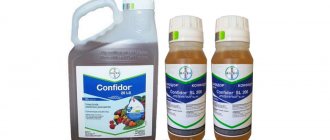Content
- Purpose and application
- Composition and dosage form
- Mechanism of action
- Application regulations
- a) Regulations for the use of “Maxim Dachnik, KS” for private farms
- b) Regulations for the use of “Maxim, KS” for agricultural production
- Compatibility
- Analogues of "Maxim" and drugs containing fludioxonil
- Restrictions and security
- Benefits of use
"Maxim" is a contact fungicidal protectant for seed potato tubers, grain seeds and other crops. In the material - purpose, types of drugs, regulations for use (dosage and consumption rates), restrictions, compatibility, etc.
Purpose and application
The preparations are used in agricultural production and private plots for processing (dressing) seed material for preventive protection against the following diseases:
a) for personal subsidiary plots
| Culture | Harmful object |
| Potato | Fungal diseases of potatoes (seed potatoes - rhizoctonia blight, fusarium blight, when storing - fusarium blight, phomosis, alternaria blight, anthracnose, silver scab, wet rot) |
| Onion | Rot of the neck and bottom, etc. |
| Spring and winter garlic (planting material) | Black moldy, gray and other rot |
| Flowering plants (flower bulbs and corms) | Complex of common soil infections |
Examples of potato rots (rhizoctonia, fusarium, alternaria)
b) for agriculture
| Culture | Harmful object |
| Winter and spring wheat | Smut, fusarium, rhizoctonia and helminthosporium root rots, seed mold, septoria |
| Spring and winter barley | Stone smut, root rot, seed mold, powdery mildew, net and dark brown spots |
| Winter rye | Stem smut, all types of root rot, typhullous snow mold, seed mold |
| Oats | Helminthosporium root rot, red-brown spotting, molding of seeds |
| Corn | Bladder smut, root rot, molding of seeds |
| Peas for grain | Root rot, Fusarium wilt, ascochyta blight, gray rot, seed molding |
| Sunflower | Phomopsis, white, gray, dry rot, alternaria |
| Sugar beet | Root beetle of seedlings (fungi of the genera Thomas, Pythium, Rhizoctonia, Aphanomyces, Fusarium), molding of seeds |
| Soybeans | Fusarium root rot, ascochyta blight, seed molding |
Examples of common root and basal rots
What specific diseases does it protect against?
The working solution of the “Maxim” disinfectant, prepared in strict accordance with the instructions for use, has a pronounced immunomodulatory effect. Seeds treated with this product germinate evenly and quickly. At the same time, potato tubers become much more resistant to late blight. "Maxim", among other things, is the only product on the market that can control a disease of this widespread crop, such as silver scab.
This drug perfectly protects grains from root rot, snow mold, ergot, and loose smut. “Maxim” prevents the development of similar diseases on corn. In this case, it can also be used to prevent the development of stem rot.
Composition and dosage form
The basic active ingredient of the Maxim series drugs is FLUDIOXONIL , chemical class - phenylpyrroles.
Fludioxonil [4-(2,2-difluoro-1,3-benzodioxol-4-yl)-pyrrole-3-carboxylic acid] is a chemical active ingredient of pesticides, used (including in mixtures with other active components) in agriculture to combat diseases of agricultural crops.
Synonyms: fludioxonil, phenylpyrrole, sapphire, celeste, maxim.
Preparative form of release – KS (suspension concentrate)
| Type of drug | Composition/dosage a.v. | Peculiarities |
| Maxim KS | Fludioxonil, 25 g/l | Basic drug |
| Maxim Dachnik , KS (special format for private household plots) | Fludioxonil, 25 g/l | Basic drug |
| Maxim 480 , KS | Fludioxonil, 480 g/l | Contact protectant with a pronounced fungicidal effect (active dosage 48%) |
| Maxim XL , KS | Fludioxonil, 25 g/l; Mefenoxam, 10 g/l | To protect corn seeds, one of the most effective drugs against stem and root rot, seed mold |
| Maxim Gold , KS | Fludioxonil 25 g/l; Mefenoxam, 10 g/l | Fungicide for protecting soybean seeds from seed and soil infections |
| Maxim Quatro , KS | Fludioxonil, 37.5 g/l; Azoxystrobin, 15 g/l; Mefenoxam, 30 g/l; Thiabendazole, 300 g/l | A new improved preparation for protecting seeds and seedlings from soil and seed infections, provides maximum protection in conditions of early sowing and return of cold weather |
| Maxim Plus , KS | Fludioxonil, 25 g/l; Difenoconazole, 25 g/l | Fungicide for protecting winter wheat seeds |
| Maxim Forte , KS | Fludioxonil, 25 g/l; Azoxystrobin, 10 g/l; Tebuconazole, 15 g/l | Three-component fungicide for the protection of winter wheat, corn, sunflower, sugar beets |
| Maxim Extreme , KS | Fludioxonil, 18.7 g/l; Cyproconazole, 6.25 g/l | Fungicide for protecting grain seeds from a complex of pathogens that cause soil, seed and first attacks of aerogenic infections. |
The registrant and developer is the Swiss company Syngenta AG, a world leader in the production of plant protection products and seed material.
Examples of fungicidal disinfectants "Maxim" for agriculture
Advantages of Maxim seed treater
Also check out these articles
- Potassium monophosphate
- Shantane carrots: photo, description of the variety, characteristics
- Salad mustard
- Selaginella
- A highly effective drug against stem and root rot, seed molding caused by fungi of the genus Fusarium spp., Pythium spp., Aspergillus spp., Penicillium spp.;
- Long-term systemic and contact activity, long-lasting protective effect;
- Standard disinfectant for seed production, accepted by all leading seed companies;
- Complete and uniform coverage of the seed and strong retention of the drug on it even in the case of repeated treatment with insecticidal disinfectants;
- High quality of the preparative form, facilitating uniform application and fixation of active substances on both hydrophilic and hydrophobic areas of the seed surface;
- An ideal partner for tank mixtures with insecticidal disinfectants (Cruiser 350);
- Easy-to-use formulation and low consumption rate;
- Possibility of long-term storage of treated seeds.
Mechanism of action
The drug "Maxim" is a protective and curative fungicide of contact and systemic action.
The fungicide was discovered in the 90s, when scientists discovered that the antibiotic pyrronitrine contained in the bacteria Pseudomonaspyrocinia suppresses all dangerous pathogens of wheat, rye, potatoes and other crops, but is safe for all other organisms. Subsequently, a chemical preparation similar to the natural one was synthesized. A new class of fungicides – phenylpyrroles – has been patented. This is how the drugs “Beret” and “Maxim” appeared.
Fludioxonil blocks the growth of mycelium, suppresses the phosphorylation of glucose during cellular respiration, which leads to disruption of the function of cell membranes.
The total period of protective action is up to 90 days. The period of protective action in the soil is determined by the persistence of the substance in a particular soil and reaches 30 days, which is quite enough for the crop to strengthen and acquire immunity after planting. The period of protective action when treating seeds is up to 1 year, which allows them to be treated in advance.
"Maxim KS", Maxim Dachnik, KS" - fungicide, disinfectant for private farms
Application regulations
a) Regulations for the use of “Maxim Dachnik, KS” for private farms
The concentrate is first dissolved in the required amount in 1/3 of the volume of water, mixed thoroughly, then the volume of water is brought to the required volume. Treatment is carried out by spraying, once. The working solution should be used within 24 hours from the moment of preparation.
| Culture | Dosage (2.5% concentrate) | Processing Features |
| Potatoes (processing before storage) | 20 ml/l. water | Treatment of tubers by spraying followed by drying, consumption 1 l./100 kg of tubers, number of treatments - 1 time. |
| Potatoes (treatment before planting) | 40 ml/l. water | Single spraying of seed tubers before planting, consumption 1 l./100 kg of tubers |
| Flower crops (planting material) | 2 ml/l. water | Treatment before planting by immersion in a 0.2% working solution, waiting 30 minutes and then drying. Consumption 1 l / 1 kg of tubers, number of treatments - 1 time |
b) Regulations for the use of “Maxim, KS” for agricultural production
Treating seeds/tubers is carried out once, immediately before sowing/planting or storing.
| Culture | Dosage (2.5% concentrate), l/t | Consumption rate of working solution, l/t |
| Peas for grain | 1,5–2 | 6–8 |
| Potatoes (processing before storage) | 0,2 | 8-10 |
| Potatoes (treatment before planting) | 0,4 | 8-10 |
| Sunflower | 5 | 10-15 |
| Spring and winter wheat | 1,5–2 | 6-10 |
| Winter rye | 2 | 6-10 |
| Sugar beet | 5–10 | 10–15 |
| Soybeans | 1,5–2,0 | 7-8 |
Instructions for use for indoor plants
Most often, this drug is used, of course, for treating planting material of garden and agricultural crops. However, “Maxim” is also the only disinfectant currently approved for use in growing indoor plants.
A product intended for this purpose is available in ampoules or bottles with a capacity of 2 to 40 ml. Treating the roots, seeds and bulbs of indoor plants with this preparation when planting or replanting them can significantly reduce the risk of flower diseases such as rhizoctonia and fusarium.
For etching in this case, a solution is usually prepared in the proportion of 4 ml of product per 2 liters of water. The manufacturer recommends mixing the composition as thoroughly as possible. One liter of the ready-made solution of the drug "Maxim" is in most cases used to treat one kilogram of planting material for indoor plants.
Analogues of "Maxim" and drugs containing fludioxonil
| Scope of application | Single drugs (fludioxonil) | Mixed preparations containing fludioxonil |
| a) for agriculture | "Geoks, VDG", "Maxim 480", "Maxim, KS", "Protect, KS", "Fludimax, KS" | “Baritone Super, KS”, “Vibrance Integral, KS”, “Deposit, ME”, “Cruiser Raps, KS”, “Magnat Total, KS”, “Maxim XL/ Gold/ Quattro/ Plus/ Forte/ Extreme, KS” , “Protect Forte, VSK”, “Switch, VDG”, “Celest Max/Top, KS”, “Flutepride, TS”, “Chancemetox Trio, KS” |
| b) for personal subsidiary plots | "Maxim Dachnik, KS" |
Restrictions and security
Hazard class for humans – class 3. Fungicide "Maxim" is low-hazard in terms of oral and cutaneous toxicity, moderately dangerous in terms of inhalation toxicity.
The drug is not toxic to bees. There was no significant effect of the drug on the main groups of phyto- and zooplankton.
Hazard class for persistence in soil - class 1. Fludioxonil has average persistence in soil. Half-life in soil is 140-350 days in laboratory conditions, 10-25 days in field conditions.
Storage rules
The disinfectant "Maxim" belongs to the third hazard class. That is, if used incorrectly, it can harm both people carrying out the work and plants. Therefore, the instructions for using this product should be followed exactly. The same applies to chemical storage. This product should also be stored in accordance with some of the manufacturer's recommendations. Store Maxim canisters and packages in a separate room (or pantry), limiting access to the fungicide for children and animals. This drug should not be stored in direct sunlight or at high air humidity.
Benefits of use
- "Maxim" is one of the most effective drugs for protecting most crops from soil-borne phytopathogens.
- The drug is not resistant, because There is no cross-resistance to fludioxonil.
- Multicomponent preparations additionally minimize the effects of temperature stress. This allows you to plant crops early and not have to worry about late frosts.
- Fludioxonil is an analogue of the natural antibiotic pyrrolnitrin, different from substances from other chemical groups.
- All drugs in the Maxim series contain only safe active ingredients.
- The Maxim series preparations have a maximum spectrum and a prolonged effect on the phytopathogenic complex, without having a negative effect on beneficial soil microorganisms.
- There is no risk of phytotoxicity if the instructions for use are followed.
- Relatively low cost of the drug.
- A colored marker allows you to control the quality of treatments.
